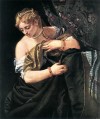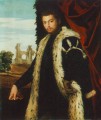Artists

Paolo Veronese
- Country:
- Italy
- Birth year:
- 1528
- Death year:
- 1588
Paolo Veronese (1528 Verona-1588 Venice), born Paolo Caliari, most likely learned his craft from Antonio Badile in Verona. He went to Venice in 1553, where he spent his life except for a stay in Rome in 1560-1561. From 1553 he worked in the Sala del Gran Consiglio (Hall of the Great Council) of the Doge's Palace, and from about 1555 to 1570 on the interior decorations of the church of San Sebastiano. In 1561-1562 he painted the famous frescoes in the Villa Barbaro in Maser near Treviso. The oeuvre of this multifaceted late Renaissance artist includes ceiling frescoes, altarpieces, mythological narratives and portraits. Along with Titian and Tintoretto, Veronese is one of the triad of great Venetian painters of the Cinquecento. After his death, his brother Benedetto and his sons Carlo and Gabriel continued his work, signing themselves "Paul's Heirs." Among his works are Madonna with the Cuccina Family, 1571, Gemaldegalerie Alte Meister, Dresden; Bathsheba in her Bath, 1575, Musee des Beaux-Arts, Lyon; and Four Allegories of Love, c. 1580, The National Gallery, London.









